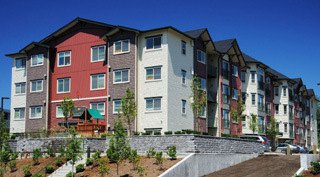
Surveys
DJC.COM
December 11, 2008
Suburban hubs will draw tomorrow’s renters
Colliers International

Levin
|

Davis
|
It is not easy to look ahead in the real estate investment market, especially in these times when major economic changes are occurring around us so quickly. The negative economic conditions are affecting all of us in the immediate term. But, we need to stay focused and keep a clear vision on how the current events are affecting all aspects of real estate markets, including multifamily properties.
The Seattle area has fared well compared to other areas, although we are not immune to the national and international impact.
Apartment rentals maintained a low vacancy this year, averaging between 4.5 percent to 5 percent throughout the greater Seattle area, which is historically low. Rents increased on average about 7 percent this year, a strong showing in a recessionary environment.

|
As single-family and condo purchases stalled, renters were less inclined to buy, and affordability of housing became a major concern.
The gap between home ownership and rental is declining, but still a significant factor, with average apartment rents about $1,000 per month in King County, and the cost of ownership much higher. With median household incomes under $70,000, there is a large population that will most likely be in the rental market much longer.
The trends for rental housing show an increasing population of renters in the Puget Sound area in the years to come. Regional population and employment forecasts are for multifamily households to increase by an average of 1.8 percent per year over the next 20 years, versus single-family households at a rate of 1.2 percent. While this doesn’t sound like a big increase in percentage, the numbers of renter households are expected to increase by 45 percent in the next 20 years.
In November, Proposition 1 for expansion of light rail was approved by voters.

Photo courtesy of Express Construction Sunset Station Apartments opened earlier this year just two blocks from Sound Transit’s light-rail station near Sea-Tac Airport. |
By 2020, a number of other considerations, in addition to the price tag, will influence rental decisions. Renters will be forced to weigh external costs as well, such as the value of their time when they sit in increasing congestion, commuting costs, and their footprint on the environment. As a result of these and other factors, renters of the future will be drawn to suburban hubs, which will offer them easier access to amenities, transit and recreation.
We define a suburban hub as the central area in a peripheral city which offers business, commercial, residential and mass transit options. A suburban hub is designed for walking, transit and bicycle use, reducing the need for cars.
Many agencies, including Sound Transit and the Puget Sound Regional Council, have identified similar communities, which they refer to with terms such as urban centers, suburban clusters and compact communities.
We believe three factors will make the rise of the suburban hub inevitable: demographic trends, the region’s transportation plans, and economic factors such as housing and commuting costs, including parking and gas.
Demographic trends
Between 1960 and 2005, the region’s population grew from 1.5 million to nearly 3.5 million. This growth is largely due to sizable net migration into the region by newcomers attracted to the strong job market. Job growth has been a primary driver in the region’s population growth and today Puget Sound boasts an employment base of nearly 1.9 million jobs.
Looking forward, population in this region is expected to exceed 4.1 million by 2020, representing a 1.2 percent growth over the upcoming decade.
Both employment and the number of households are expected to grow at a slightly higher rate than the population during that time. This projection reflects changing demographics, such as the aging of the population, and the tendency for smaller numbers of families and fewer children. As a result of these trends, the proportion of the region’s multifamily households is expected to rise from 31 percent of all households in 2000 to 33 percent in 2020 and 35 percent in 2030.
King County is expected to receive 40 percent of the region’s population growth from 2000 to 2040, with an increase of 500,000 people. However, the surrounding counties will likely see higher percentages of population growth during this time. As population climbs throughout the region, new housing and commercial activities will be pursued more intensely within urban growth areas. These urban growth areas will allow higher density and consequently support the development of suburban hubs, which will allow the increasing number of multifamily dwellers to have access to neighboring amenities.
Economic factors
With an estimated growth of 50,000 people each year for the next 20 years, Puget Sound will continue to experience less predictable traffic, more congestion and longer commute times. Paired with rising fuel costs and residents’ increasing consciousness of their carbon footprint, these external factors will likely contribute to the appeal of suburban hubs.
Congestion and commute times. According to the Puget Sound Regional Council’s Destination 2030 Update Report, in the Central Puget Sound region, as in other urbanized regions of the country, congestion causes delays and frustrations for drivers, and wastes millions of dollars of economic resources each year.
Despite serious congestion, the average commute time has not grown by more than a few minutes since 1989, indicating that people make other lifestyle adjustments to keep commute times reasonable. Commuters are then faced with challenges of living closer to work and rearranging schedules to accommodate reasonable commute times from home to their employment location. However, this can be a challenging affordability issue since living downtown, where many renters work, is not as affordable. They must either find space within a limited number of affordable housing programs in downtown areas, or commute into the city from more affordable areas.
Commuting costs. With pricey gasoline and parking costs escalating due to limited parking availability in downtown, commuters are more sensitive to the costs of using their automobiles. In the past year alone, Metro has recorded an increase in ridership in King County of more than 7 percent. This is believed to be the largest annual increase of ridership for Metro in the past 10 years, triggering a distinct push towards public transportation options.
Transportation plans
Sound Transit plans to open the first portion of light rail in Seattle in 2009, with a travel time between Tukwila and downtown Seattle of approximately 30 minutes. Stops have been planned to coincide with the location of already-established hubs, including those in downtown Seattle, Capitol Hill, University of Washington and Northgate. With recent approvals for extending the light rail to Lynnwood and the Eastside eventually, light-rail lines could open up even more connections to other suburban areas.
Multifamily opportunities
State and local governments will continue to encourage the development of high-density mixed-use buildings in close proximity to Link light-rail stations. In order to spur this development, there are likely to be a number of incentives for developers, including:
Tax incentive zones for transit. This might include tax breaks for mixed-use developments in targeted locations, such as areas around transit stations and along transit corridors. Fostering development in these areas would provide access to transit to a greater number of people, thereby reducing the need for automotive use.
Multifamily tax abatement programs. These encourage new multifamily housing by forgiving the property tax payments for a period of time. Extending this program to all designated urban centers, and possibly transit station areas, could foster housing development in these areas.
Development of multifamily housing. This will provide the renter with housing, grocers, retail, entertainment and transportation in a dense area. Renters will have the ability to live outside of the city and have drastically shorter commute times without the expense associated with an automobile.
The combination of the region’s multifamily household growth forecast, rising costs of commuting, and increased congestion on main arterials and freeways is leading the Puget Sound to develop housing in hub locations, some that will be served by light-rail stations. This concentration will provide residents an alternative for commuting and create a new premium residential housing hub.
Joe Levin is vice president of multifamily investments and Jason Davis is associate of multifamily investments at Colliers International in Seattle.
Other Stories:
- CBA speakers take on the economy
- A green future for savvy developers
- Making green design deliver ROI, not just LEED
- Market District evolves as a walkable neighborhood
- Mixed-use projects can pay off handsomely
- Local retailers will fare better than others
- Seattle’s office market: No more high-fiving
- Industrial market hums along, but don’t hold your breath
- CBA ready to mint a new breed of green brokers
- Weathering the storm
- Young guns take their shot at the market
- David A. Sabey
Sabey Corp. - Sean G. Hyatt
Trammell Crow Residential - Lynn Michaelis
Weyerhaeuser Co. - Dan Ivanoff
Schnitzer West - Commercial real estate prepares for the future
- The pitfalls of renting out condo projects
Copyright ©2009 Seattle Daily Journal and DJC.COM.
Comments? Questions? Contact us.